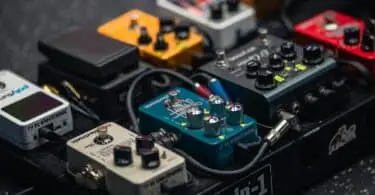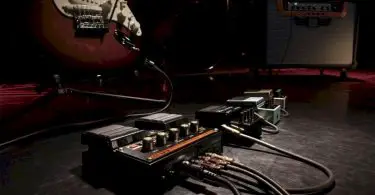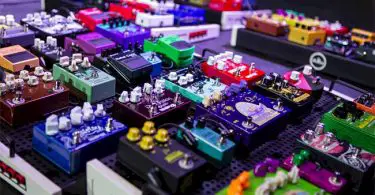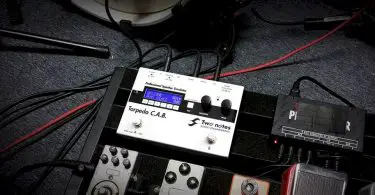Alternate tunings allow musicians to go beyond the possibilities of standard tuning. However, constantly tuning in to a different tune can quickly become a drag. Drop tune pedals let players effortlessly drop into their preferred tuning by simply pressing a switch.
In this article, I’m going to review some of the most popular drop tune pedals4. Some of these pedals only affect the tuning, while others have a few more effects.
At first glance, these pedals might seem like a godsend for players who constantly alternate between tunings; however, the new tuning will always be relative to the standard tuning.
This means that a drop tune pedal won’t just drop your low E-string to a D — it will lower every single string accordingly. The upside is that you’re able to play in a lower register without having to tune every string. For a single string drop, you’re going to have to do it the old way.
When you buy through links on our site, we may earn an affiliate commission. As an Amazon Associate I earn from qualifying purchases.
Quick Links
Best Drop Tune Pedals — Comparison Table
- DigiTech DROP Compact Polyphonic Drop Tune Pitch-Shifter
- Momentary mode
- Good pitch-shift range
- Great quality build
- Electro-Harmonix Pitch Fork Guitar Pitch Effect Pedal
- Synth-like effect
- Momentary mode
- Wide transposing range
- DigiTech Whammydtv-01 DT Drop Tune Guitar Effects Pedal
- Combines a Whammy and a Drop
- Pitch-shift from a half-step to a full octave with ease
- Momentary mode
- BOSS OC-3 Electronic Keyboard Pedal or Footswitch (OC3)
- Cheap
- Two-octave range
- Good when distorted
- Morpheus DT1 Polyphonic pitch drop FX pedal
- Very cheap
- Good for bedroom-only players

➡ Drops tuning from 1 semi-tone to a full octave
➡ Nine pitch modes
➡ True bypass

➡ 6-octave transposing range (three up and three down)
➡ 11-position knob controls the transposing interval
➡ Pitch can be controlled through an optional pedal

➡ Polyphonic pitch shifting and whammy effects
➡ Drops tuning from half-step to entire octave
➡ True bypass

➡ Polyphonic octave effects
➡ Drive mode applies distortion to octaves

➡ Drops tune from a half-step to a full octave
Best Drop Tune Pedals Review
1. Digitech DROP Compact Polyphonic Drop Tune Pitch-Shifter
- Momentary mode
- Good pitch-shift range
- Great quality build
➡ Drops tuning from 1 semi-tone to a full octave
➡ Nine pitch modes
➡ True bypass
The DigiTech Drop is one of the most popular drop tune pedals for a reason. It’s a simple and easy way of dropping the tuning from 1 semi-tone all the way down to a full octave.
Lowering the pitch is very easy as you just need to turn the knob to the desired position. You’ll always know how far you’ve gone due to the indicator LEDs. Put the knob in the far-right position, and you’ll have your guitar sounding just like a bass.
Although it doesn’t offer any other effects other than pitch shifting, the Drop has a very useful feature: momentary mode. With the momentary mode activated, the effect is only applied while you are pressing the switch. Let go of the switch, and the effect is turned off.
The sound quality is good, and the pedal has a solid build. The Drop is a great addition to any guitarist looking for a drop tune pedal.
Should you put this pedal before or after a distortion pedal?
You should experiment with the pedal position in the chain until it is to your liking. Although there’s no set position, placing it right after the compressor preserves the signal better.
Does this pedal work with 8-string guitars?
Yes. This pedal would work with any amount of strings since it always drops the tuning of every string.
Who this is for?
Someone looking for a drop tune pedal with a good pitch-shift range.
Why I like it?
The DigiTech Drop cuts straight to the chase, and it’s a great drop tune pedal.
2. Electro-Harmonix Pitch Fork
- Synth-like effect
- Momentary mode
- Wide transposing range
➡ 6-octave transposing range (three up and three down)
➡ 11-position knob controls the transposing interval
➡ Pitch can be controlled through an optional pedal
Although it is also capable of just dropping the tune, the Electro-Harmonix Pitch Fork is also capable of delivering synth-like qualities.
This pedal can lower and raise the pitch — individually or at the same time. You can go three octaves up and down from the original tune at the same time, which completely changes your sound.
If you’re just looking for tune dropping, then this pedal is also very capable of that, but it might disappoint you if you’re also looking for precision. While the transposing range is considerably wide (+/- 3 octaves), you can’t transpose a semi-tone at a time. The transposing intervals are fixed.
Just like the DigiTech Drop, the Pitch Fork also has a momentary mode.
Who this is for?
Someone looking for a wide transposing range and synth-like effects.
Why I like it?
The Pitch Fork works great as a tune drop pedal while also allowing for some more versatile effects.
3. DigiTech Whammydtv-01 DT Drop Tune
- Combines a Whammy and a Drop
- Pitch-shift from a half-step to a full octave with ease
- Momentary mode
➡ Polyphonic pitch shifting and whammy effects
➡ Drops tuning from half-step to entire octave
➡ True bypass
Many different musicians use the Whammy to make ear-catching riffs. This pedal combines a Whammy and a Drop, effectively giving you two pedals in one package.
The whammy pedal emulates a Stratocaster’s whammy bar, pitch-shifting the notes being played. It’s a pedal used by guitarists who don’t have (or don’t want to use) a whammy bar, such as Tom Morello.
When combined with the Drop, the Whammy DT is capable of pitch-shifting notes in an already pitch-shifted tuning. This pedal has the same drop tuning capabilities as the DigiTech Drop, so it’s always going to be a good drop tune pedal.
Like the DigiTech Drop, the Whammy DT also has a momentary mode.
Does this pedal come with a power supply?
Yes, it does.
Does this pedal take batteries?
No, this pedal only uses a DC adapter.
Who this is for?
Someone looking for a Drop and a Whammy.
Why I like it?
This pedal combines two excellent pedals in a single unit.
4. BOSS OC-3 Electronic Keyboard Pedal or Footswitch (OC3)
- Cheap
- Two-octave range
- Good when distorted
➡ Polyphonic octave effects
➡ Drive mode applies distortion to octaves
The Boss5 OC-3 is a cheap drop tune pedal that goes up to two octaves down. It’s a good pedal if you’re on a budget, but you might find its limitations somewhat infuriating.
First of all, you can’t accurately control the pitch-shift. If you want to shift your pitch in semi-tone increments, you won’t be able to do that with the OC-3. The pitch is controlled by an unprecise knob, and you’ll have to do a rough estimate regarding what a semi-tone is.
The second thing is that this is a very hot pedal. It sounds good when distorted, but it also produces muddled sounds in a clean setting. It might be good enough for some use cases, but it can be problematic in others.
The output is a little synthetic, which can also be slightly off-putting. Other than that, this is a cheap pedal that works — but probably not exactly how you want it to.
Does this pedal produce higher octaves?
No, this pedal only produces up to two lower octaves.
Who this is for?
Someone looking for a budget drop tune pedal.
Why I like it?
Boss makes good quality-price pedals, and the OC-3 is a great example.
5. Morpheus DropTune Pitch Drop Pedal
- Very cheap
- Good for bedroom-only players
➡ Drops tune from a half-step to a full octave
The concept behind the Morpheus DropTune is simple: you drop a semi-tone whenever you press the button. In theory, it works fine. In practice, however, the sound sounds over-processed and loses a lot of quality when compared to the original tone.
The high-end gets lost in the pedal, and the low-end suffers from some quality loss as well. There are even cases where you can hear both the original signal and the transposed one, resulting in an unpleasant cacophony.
This is a good pedal if you’re on a minimal budget and don’t plan on doing anything else other than fiddling with it in your room. It’s good to play around with, but not adequate for a live or studio setting.
Who this is for?
Bedroom players on a budget who want a pedal to toy with.
Why I like it?
It’s cheap and kind-of does what advertises.
Wrapping Up
Drop tune pedals6 are a great way of quickly changing your tune. They’re usually not very expensive and can add some expression to your guitar-playing.
Overall, I found the best pedal to be the Digitech Drop Tune Pitch-Shifter. This pedal is a simple drop tune pedal that’s easy to use and offers a wide tuning range.
If you’re looking for something a little more elaborate, then the Electro-Harmonix Pitch Fork and the DigiTech Whammydtv-01 are both great choices that go beyond a simple tune drop.
I’d recommend most pedals on this list to any player, except for the Morpheus DropTune. This pedal should only be used by bedroom players, and even then, they could probably save for a better pedal.
Which drop tune pedal is your favorite?
Best Drop Tune Pedal — Buyer’s Guide
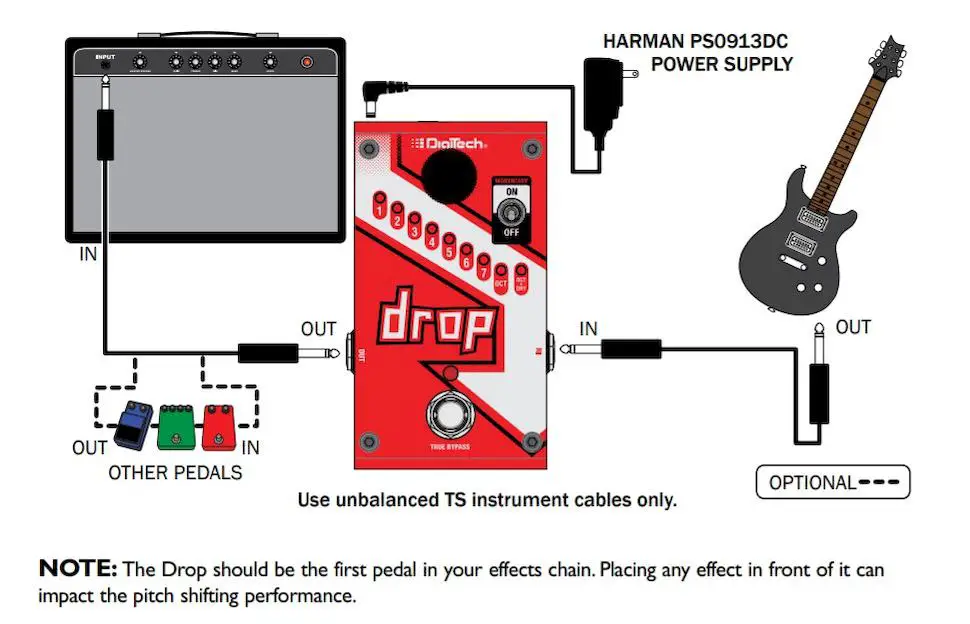
Drop Tune Pedal Connection Diagram
Digitech The Drop Test
With a polyphonic pitch-shift effect, the guitar can be tuned down to one octave at the touch of a button, all in a small pedal format. Thanks to powerful processors, polyphonic pitch shifting is neither technically nor financially a significant problem nowadays, and you can confidently leave your second and third guitar at home. At least in theory, because of course, the most important thing is and remains the sound and, of course, how well the electronic helper does his job.
Details
Housing/Optics
The tuning machine comes in a sturdy sheet steel housing with the controls mounted on the top as usual. The red paintwork is reminiscent of the legendary Whammy pedal, and it is not only in terms of color that there are similarities between the two devices. The drop algorithm originally comes from the Whammy DT. However, our test device only allows for down- tuning, while the original also shifts the pitch upwards. I find this slimmed-down version okay because for the pitch shifting upwards, there is still the analog capo. The controls are very straightforward. There is an endless grid potentiometer that determines the tuning mode; the LEDs below it show the corresponding selection. With the toggle switch, you can still set how the Footswitch should work, either as a standard switch (Latch) or as a button (Momentary), where the effect is only active as long as you keep the Footswitch pressed. When the Footswitch is on, the LED above it will light up.
And that’s all there is to it with the setting options, there’s nothing more to it, and that’s fine. Our pedal is just supposed to tune down, EQ or other features are not needed – less is more here. The Drop has a true-bypass circuit where the signal doesn’t pass through the digital circuit when the effect is off. Such a digital device, where the processor has to do a lot of work, also wants to be well-fed, and 300 mA is a clear statement, which is why one refrained from battery operation, and the matching 9 Volt power supply is included. The connection for it is found at the front of the pedal, input, and output at the sides.
Operation
In down-tuning mode, whose presets are displayed with the numbers from 1 to 7, the complete guitar signal can be tuned down by the corresponding number of semitone steps. The original signal is, of course, switched off. With the low E-string, we would thus have the following tones:
1 – Eb/D#
2 – D
3 – Db/C#
4 – C
5 – B
6 – Bb/A#
7 – A
Also, there are two-octave modes, in which a pitch shift command is generated from one octave down. Once without the original signal (Oct.), then you are in the frequency range of electric bass. In Oct & Dry mode, both signals can be heard. But the mixing ratio is not adjustable.
Practice
We start the practical test right away with a tough task. The Drop is fed directly with a few chords over five and six strings. The whole thing with a clean sound that brings all the dissonances to light immediately if the pitch shifter cannot analyze the chord correctly. First, you hear the guitar without any effect. Then it goes step by step into the tuning cellar, modes 1 to 7 are played one after the other.
Down-tuning Modes 1-7
Of course, you can hear the difference in sound as soon as the effect is switched on. The sound becomes mustier, and in the basses, it gets a bit undefined, especially when playing chords. But as harmless as it may sound with the three standard chords, the processor already has to do quite a bit. The tones on the individual strings are accurately analyzed and pitch-shifted, without any dropouts or artifacts. A few years ago, this could only be done by picking each string individually, for example, with the Roland V-Guitar System or the Line 6 Variax models. But that required a lot more money on the counter than the drop pedal. When down-tuning up to three semitones, undistorted chord strumming also works, below that it becomes a bit opaque, especially if you spend a lot of time on the low strings in polyphonic use.
The preset with the octaver without the original signal is very well suited to play a layout bass quickly.
Octaver Bass
Now we come to the second key question, namely that of tracking and latency. And that works amazingly well! I have the feeling that the greater the sound shift, the more sluggish (higher latency) it gets. In the first three down-tuning modes, the latency is very low, and in any case, it is easy to get over in live operation.
Now follows a typical application example from practice. You want to play some blues-style riffs, and the whole thing please on Eb (a semitone lower than fingered), as Hendrix and Vaughan liked to do. With a crunch sound, this works accordingly, although the pitch-shift effect is also noticeable here, as with the clean sound. If you’re too fussy, you’d better take your second strat to the gig. But for the rehearsal, this is always sufficient.
Eb-Tuning – Strat, Stevie Ray Vaughan Style 1
For jamming at home, retuning by pedal is also advantageous and uncomplicated. But there is a little problem because if you play softly over the amp, you will hear the strings of the instrument sounding in their original pitch. If there is a difference of half a tone, this is truly no pleasure. In this case, you should play with headphones or turn up the amp so far that you can’t hear the strings acoustically. Have fun with your roommates!
Now it’s time for the higher distorted sounds, and you hear an SG first without the drop pedal, then with the pitch shift effect two semitones lower (2).
Mid Gain – SG guitar without the drop pedal
The slightly higher output level of the humbucker pickups does not affect the sound or tone recognition of the drop pedal, there are no preferred types here, whether, with single-coil or humbucker, everything is equally recognized. Even if you turn down the volume knob on the guitar, the quality of the tone detection is not reduced.
Finally, let’s listen to the results with high distortion, using a guitar in Drop D tuning, which is pushed down a little by The Drop. into modes 3, 4, and 5. The D on the low string becomes B (3), Bb (4), or A (5). In this range, if you play a few strings with a clear and defined attack, the Drop pedal comes into its own and does an outstanding job.
Metal Sound – SG in Drop D-Tuning
Verdict
It’s incredible what a processor can do in a small pedal. The Drop Pedal from Digitech does an excellent job in electronic down- tuning. Even with chord strumming on all six strings, there are no annoying background noises, the tone recognition works perfectly, and the latency in the down-tuning modes is also kept within manageable limits. To what extent this is a disturbing factor for the individual, everyone has to decide for himself. The same applies to the sound quality, which, of course, cannot be equated with a lower tuned guitar. When the effect is activated, the sound becomes a bit mustier. At greater distances from the original, it becomes a bit muddy in the bass range, especially when playing chords. It works well with single-note riffs and power chords with a defined attack. But the bottom line is an excellent performance.
- https://medias.audiofanzine.com/files/digitech-drop-manual-473151.pdf
- https://www.academia.edu/33236446/BOSS_GuitarEffects_Catalogue
- https://digitalcommons.calpoly.edu/cgi/viewcontent.cgi?article=1451&context=eesp
- https://medias.audiofanzine.com/files/digitech-drop-manual-473151.pdf
- https://www.academia.edu/33236446/BOSS_GuitarEffects_Catalogue
- https://digitalcommons.calpoly.edu/cgi/viewcontent.cgi?article=1451&context=eesp

